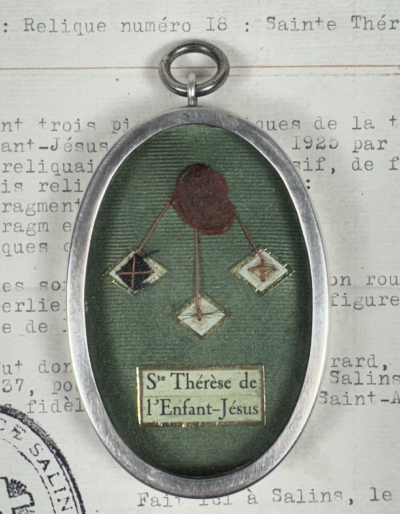Saint Therese de Lisieux († 1897), popularly known as "The Little Flower of Jesus," was a Roman Catholic French Discalced Carmelite nun widely venerated in modern times. After nine years as a Carmelite religious, having fulfilled various offices, and having spent her last eighteen months in Carmel in a night of faith, she died of tuberculosis at the age of 24. Thérèse has been a highly influential model of sanctity for Catholics and for others because of the "simplicity and practicality of her approach to the spiritual life." Together with Saint Francis of Assisi, she is one of the most popular saints in the church's history. Pope Pius X called her "the greatest saint of modern times." She is a holy patron of Gardens of Vatican City, Missionaries; France; Russia; HIV/AIDS sufferers; radio care-a-thons; florists and gardeners; loss of parents; tuberculosis; and the Russicum; Alaska. Therese was beatified in 1923 and canonized on 17 May 1925 by Pope Pius XI, only 28 years after her death. Her feast day is commemorated on 1 October.
Large oval solid silver glass-fronted reliquary theca housing three relics of Saint Thérèse de Lisieux: the first-class ex ossibus (of the bone), ex capillis (of the hair), and the second-class ex velo (of the veil). The relics are affixed to a blue silk ground attached by red silk threads to a seal of Spanish wax bearing an imprint of a coat of arms of a French Cardinal Pierre-Marie Paul Gerlier (†1965), the Archbishop of Lyon and the Primate of Gaul (1937–1965). The relics are identified in French on a typeset cedula label as Ste. Thérèse de l'Enfant-Jésus. (St. Therese of Child Jesus). On the back, under a protective glass, the theca contains a portrait of Saint Therese. The reliquary comes with a letter of testimony (with the original envelope) from a parish priest of Salins, France, dated February 17, 1938.
This document, which is stamped with the parish stamp, describes and explains the relic. It is said that it is sealed by Monsignor Gerlier, and that it was given to the parish of Salins on October 1, 1937 by Bishop Evrard, and that it was exposed to the veneration of the faithful in the Saint-Apollinaire church. The seal stamp is from the Diocese of Meaux, in France.
Additional Info
- ID#: 01-RSGA-12
- Size: 7.5 x 5 cm (3 x 2 inches)
- Age: ca. 1938
- Origin: Salins, France
- Materials: silver, glass, silk, paper, Spanish wax
- Price: SOLD!
-

Additional Images of this Item
Online Store & Services
Information
Quick Link
Information
Quick Link
SAVE 5% from your first purchase when you subscribe to receive our infrequent mailings with updates on new arrivals, exclusive offers, and fascinating stories on relevant subjects.








 Поменять язык на русский
Поменять язык на русский 